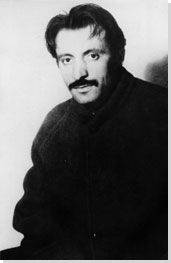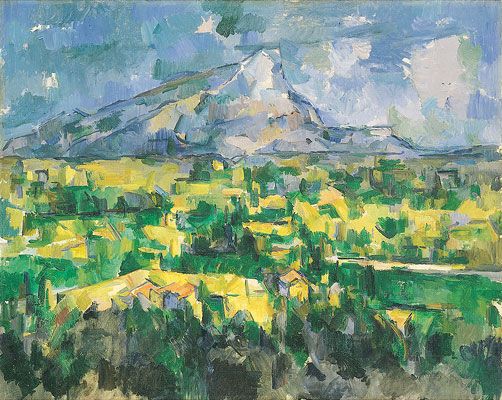Summary of Arshile Gorky
Arshile Gorky's diverse body of work was crucial to the emergence of Abstract Expressionism. He adopted the biomorphic forms of the Surrealist painters, but further freed those forms through the process of painting itself by emphasizing more lyrical color and personal content. By means of his unique approach to color and form, he was able to communicate to the viewer the painful childhood experiences of the Armenian Genocide as well as the pleasant and nostalgic sentiments he felt toward his lost homeland. His work is also significant because it so directly reflects the cultural and historical milieu of New York in the 1940s, where avant-garde artists from both the United States and Europe converged, and of the postwar period in general, when existentialist philosophy prevailed. This philosophy proclaimed the absurdity of life at the same time as it called upon humans to take responsibility for creating their own meaning - which Gorky did by creating beauty out of personal tragedy.
Accomplishments
- Many of Gorky's works reflect both the artist's traumatic past as a genocide survivor and the memory of the exquisite beauty of his early childhood surroundings in Armenia. Through the process of painting itself, Gorky could begin to resolve his largely tragic life by transforming real people and real objects, remembered or present, into new realities, abstracted and controlled.
- Gorky pioneered the trend of naming his abstract compositions with titles directly referring to particular objects and places, thus fusing objective reality and subjective feeling in his works.
- Gorky's work is particularly historical significant in that it provides the most important link between prewar European modern styles and the emergence of Abstract Expressionism in America during the 1940s.
Important Art by Arshile Gorky
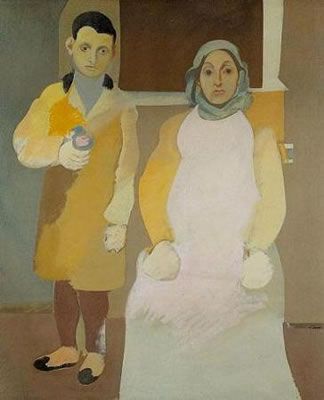
The Artist and His Mother
Gorky's early work The Artist and His Mother (c. 1926-36), for which he did many drawings and painted versions, is a deeply personal composition that depicts the artist as a child with his mother, who died in his arms in 1919 following the Armenian Genocide. The treatment of the figures is reminiscent of Pablo Picasso's Blue Period paintings, evoking the same melancholic atmosphere through its palette, abstracted flatness and incompleteness. However, the more immediate source for the painting is a (frequently reproduced) photograph of the young Gorky with his mother taken in Armenia around 1912. Contrasting the painting with the original photograph is a satisfying lesson in the appreciation of modern art. Such changes from the photograph to the painting as the almost painfully negative space that evolves between the two figures, the boy's feet angling away from his mother, the emphasis on the eyes, and the expansion of the dark rectangle to create a sort of Madonna-like "cloth of honor" behind his mother's head (as well as many more subtle differences) all serve to communicate the emotional pain of the loss of his mother, whom he will never see or touch again, as well as to raise her to the status of immortal icon.
Oil on canvas - The Whitney Museum of American Art, New York
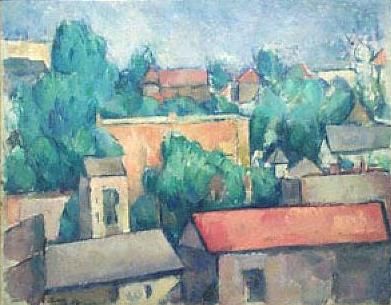
Staten Island
This early painting of 1927 is a superlative example of Gorky's "Cézanne" period. During these years, Gorky composed numerous canvases after Paul Cézanne's still lifes and landscapes. This particular landscape was painted from nature on Staten Island, where Gorky sought out a hillside reminiscent of L'Estaque, one of the beloved painting destinations of Cézanne. The rigid, architectonic geometry of private houses dominates the composition, while the warm, joyful palette imbues the view of the New York borough with the appearance of the South of France. While not precisely a copy of Cézanne, it is a careful study of the artist's style of geometric abstraction that was part of the modern movement in Europe, pointing to Gorky's desire to actively absorb styles and movements of the past in seeking his own individual style.
Oil on canvas - Jack Rutberg Fine Arts
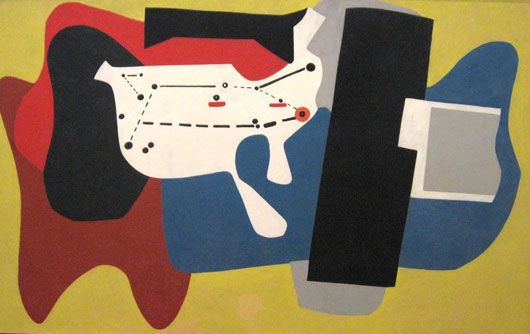
Aviation: Evolution of Forms under Aerodynamic Limitations
During the Great Depression Gorky worked as a muralist for the Federal Art Projects/Works Progress Administration (FAP/WPA). Between 1935 and 1937, Gorky produced a ten panel large-scale mural cycle for Newark Airport. Of the original murals, only two still exist; the others were either destroyed or somehow disappeared. Gorky was one of the very few New Deal muralists to paint in an abstract language.
In this mural, Gorky shows the continuing influence of European Modernism. While clearly engaged with the Cubist vocabulary of Picasso and Braque, the brilliant colors, and mechanized forms of these murals are strongly indebted to Fernand Leger. Gorky has harmoniously brought together different strands of modernism, which he uses to celebrate modern aeronautics, flight, and speed. Here, Gorky successfully deploys the language of pure abstraction with biomorphism along with a more literal representation of the United State with flight paths relevant to Newark. The modern, abstract style of these brightly colored murals sparked controversy in the 1930s as the public prized American Scene realism. Each panel stirs within the viewer the excitement of the modern machine age and spectacle of air travel in the Depression era. Further, through the mural's public placement within Newark airport, Gorky successfully introduced modernist vocabulary to a greater, non-art viewing segment of society.
Oil on canvas - Newark Museum of Art, Newark, NJ
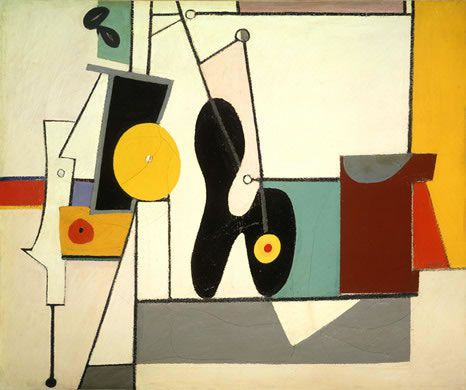
Organization
Typifying his work of the mid 1930s, the completely abstract composition Organization (1933-36) is an amalgamation of Gorky's exposure to the Synthetic Cubist works of Pablo Picasso (with flat planes that are less fragmented and linear, yet more colorful), as well as the signature organic pictorial motifs of Joan Miro. The painting explores a multitude of concepts put forth by these artists: flatness, form reduction, the arrangement of color, and images arising from the unconscious, even though Gorky preferred to let his forms be directly inspired by nature and reality. In his later work, Gorky would depart from such rigidly arranged compositions in favor of a more spontaneous painting technique, yet he would always remain attentive to the structure of his paintings.
Oil on canvas - The National Gallery of Art, Washington DC
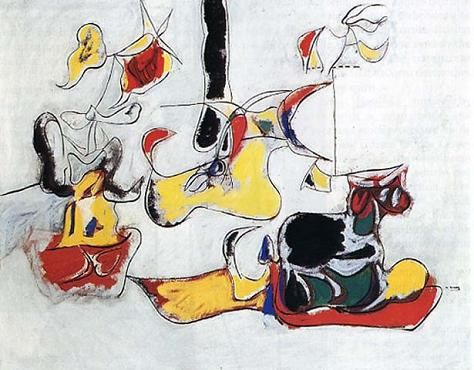
Garden in Sochi
This painting (the first of at least six relating to this theme) represents Gorky's nostalgic reflection upon the garden that was part of his father's farm near Lake Van in his native Armenia. A defining influence of Joan Miro's work can be discerned in this painting in terms of its palette, composition, and forms, with Gorky's skill as a draftsman evident in the separation of line and color. But more specifically, in a 1942 unpublished typescript that Gorky provided for the Museum of Modern Art, the artist described the garden and its objects (including carrots and porcupines), as well as its depicted motifs, including women rubbing their breasts on rocks to see their wishes fulfilled, and the "Holy Tree" with torn bits of clothing from persons visiting the tree. In the same document, Gorky also described the "sh-h-h-sh-h of silver leaves of the poplars." According to the scholar Harry Rand, Sos or Sosi is Armenian for the poplar tree that creates the sound Gorky describes. The word is also then a pun on the Russian resort Sochi, which was probably an intentional association in the same way that the artist chose the name Gorky. Ethel Schwabacher has also identified the centrally located image of an elegant shoe that Gorky's father supposedly gave him before he left Armenia. However, the viewer who insists upon too specific a reading of Gorky's images will not be fully rewarded, as the higher pleasure is in allowing his titles to suggest a subject matter, and then enabling our own memories and associations to mingle with what is on the canvas. In this sense, his works allow the viewer to revel in the lyrical play of color, following the rhythm of the curving forms as they help us pry open the memories of our own experiences that we realize are common to all humanity.
Oil on canvas - The Museum of Modern Art, New York
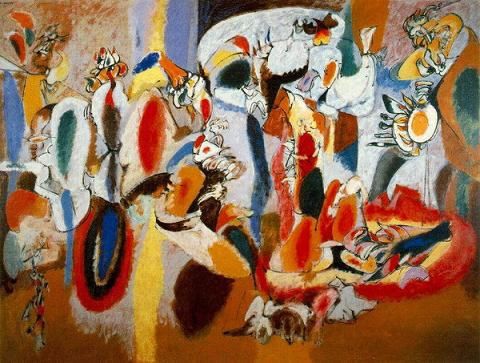
The Liver is the Cock's Comb
Though abstract to a great degree, this work nevertheless reveals Gorky's fondness for organic forms loosely based in nature and the sumptuous colors that would prove to be essential to his mature style. The work of Pablo Picasso and Wassily Kandinsky, as well as that of Joan Miro and Roberto Matta (who in 1942 suggested that Gorky use more turpentine to loosen up the paint) provided strong influences on Gorky's painting practice. In 1945, Andre Breton, the author of the 1924 Surrealist Manifesto, praised this painting for its combination of nature and reality, filtered through memory and feeling. The scholar Harry Rand has discussed the content of this picture at length, pointing out the rooster-headed figure with the feathered groin at the right as the vain fool. Rand explains that the liver was once thought of as the seat of the passions (love and lust), thus punning on the "cock's comb" part of the title, and could also be construed as "one who lives," therefore asserting that life itself is vanity and all in vain.
Oil on canvas - Albright Knox Gallery. Buffalo, NY

Agony
A studio fire, cancer operation, and emotional turmoil help explain the title of this painting executed one year before Gorky's death. Scholars (helped, as in other cases, by the study of Gorky's drawings) have suggested the presence of images including figures - perhaps at the left the pained and suspended figure of Gorky himself - in a structured interior. As with Gorky's other paintings, instead of an exact rendering, the viewer is presented with suggestions of real objects that are subjected to the artist's personal interpretation of their forms and meanings. However, the sober palette and the incisive pulling of the lines and forms in this painting inevitably lead us back to the title of the work and feelings of suffering, pain, and sorrow, yet all within the context of the cycle of life and death expressed in the malleability of Gorky's forms.
Oil on canvas - The Museum of Modern Art, New York
Biography of Arshile Gorky
Childhood
It is not exactly known when Arshile Gorky was born. 1904 is widely accepted as the year of his birth, but the precise date remains a mystery because the artist adopted the habit of changing his birthday, year after year, while residing in New York. As a child, the artist survived the genocide of the Armenian people by the Ottoman Turks. With his family displaced and dispersed, Gorky's mother died of starvation in Gorky's arms in 1919. His father, however, had escaped the Turkish military draft by moving to the United States in 1908 and settling in Providence, Rhode Island. Gorky would join his father in 1920 at the age of 15 after leaving the war-ridden territory of the collapsed Russian Empire.
Early Training
Arshile Gorky remained a largely self-taught artist before his immigration to the United States. Here he enrolled in the New School of Design in Boston, which he attended from 1922 to 1924. His new home provided the artists with his first exposure to the discourses of artistic modernism, whose founding fathers, such as the French Post-Impressionist painter Paul Cézanne, would exercise a great deal of influence on Gorky's own work in this formative period. Around 1925 Gorky moved to New York where he swiftly penetrated the emerging artistic milieu and enjoyed an ever more expansive introduction to the current artistic trends, including the groundbreaking innovations of Pablo Picasso as well as the early work of Spanish Surrealist painter Joan Miró.
It was in New York that Gorky met and developed a personal and artistic friendship with such artists as Stuart Davis and fellow émigrés, including the Ukrainian John Graham (born Ivan Gratianovich Dombrowsky) and the Dutch Willem de Kooning. New York's climate of constant artistic exchange proved auspicious for the formation of Gorky's early style that relied heavily on Cézanne's compositional method and Picasso's Synthetic Cubist forms. The colorful palette of the Fauves and European Expressionists were also formative influences on the artist.
While in New York, Gorky enrolled at both the National Academy of Design and the Grand Central School of Art, where he also taught until 1931. This was also the period when the artist changed his name, from Vosdanik Adoyan to Arshile Gorky, in order to divorce himself from the negative perception of the Armenian refugees in the United States. The change was also made to claim a certain connection to the Russian artistic milieu. For a while Gorky even claimed to be a relative of the prominent Soviet writer Maxim Gorky who enjoyed considerable fame in the West. Additionally, the name Arshile was a form of the name of Homer's hero Achilles, and Gorky was a Russian word for "the bitter one." Given Gorky's personal history and the prevalence during and after World War II of the existential philosophy that called upon humans to take responsibility for creating their own meaning, his chosen name and persona would seem apt.
The core characteristics of his early style crystalized during his first five years in New York: from Cézanne-inspired landscapes and still lifes to a flatter and more experimental rendering of the surface influenced by the Synthetic (less fragmented and more coloristic) Cubism of Picasso and his fellow artistic innovator Georges Braque. The degree to which Gorky assimilated these influences in his early works directly reflected the porous artistic context of the New York scene at that time, which provided a platform for continuous experimentation and innovation.
Mature Period
In the 1930s, Gorky's work began to enjoy public recognition. In 1930, he was included in the group show of the emerging artists assembled by Alfred Barr, Jr., the influential director of the Museum of Modern Art in New York. The year 1931 marked the first solo exhibition of Gorky's paintings at the Mellon Galleries in Philadelphia. From 1935 to 1941, the artist, alongside De Kooning, worked under the Works Progress Administration of the Federal Art Project, a major government initiative to provide artists with work at the time of the Great Depression. One of the projects conceived by Gorky for the WPA was the group of murals at the Newark Airport in Newark, New Jersey. Also in 1935, four of Gorky's paintings were included in the famed exhibition mounted by The Whitney Museum of American Art titled Abstract Painting in America, which attracted growing attention to the artist from critics and the public alike. In 1938, Gorky held his first solo show in New York at the Boyer Galleries.
By the 1940s, Gorky's paintings would move in an entirely new direction: his mature style would bear resemblance to Surrealist ideas and forms imported from Europe (though the artist eschewed the Surrealists' reliance upon the unconscious), as well as an innovative technique of paint application which anticipated, if not inspired, the Action Painting method of the Abstract Expressionist painters of the following decade.
The stylistic shift in Gorky's work is best understood through an analysis of the New York School in the 1940s, which was precipitated by a major influx of European artists and intellectuals who had moved to the city before and during World War II. Among these individuals were Josef Albers and Hans Hofmann, who had escaped Nazi Germany and established themselves as influential art teachers and theorists in New York; Erwin Panofsky, a founding father of the academic discipline of Art History in its modern form, who taught at New York and Princeton Universities; the prominent German Surrealist painter Max Ernst; the primary theorist of the Surrealist movement André Breton, who fled occupied Paris; and Piet Mondrian and Fernand Léger, who brought their unique pictorial modes as their only luggage. The confluence of these individuals made New York an ever more boisterous and diverse artistic ground, where the iconic names of modern painting, with all its variety of styles, intermingled, and prepared the way for the emergence of an inimitable New York style of painting known as Abstract Expressionism.
It is worth noting that while Gorky was dependent on outside influences throughout his career, he never directly copied his sources. Rather, he examined them thoroughly for their structure and meaning, selecting elements that could later be assimilated into his own work. As an apprentice to the early modernist tradition, Gorky became a master in his own right, his oeuvre serving as a bridge between the prewar Europeans and the postwar Americans. One example of his importance is that André Breton actively courted Gorky to join the Surrelism movement. Gorky even allowed Breton to name some of his paintings. Later, Gorky, a loner personality, disassociated himself from Breton, and the Surrelism movement - for this reason, or a number of others - disbanded.
Late Years and Death
In 1941, Gorky married Agnes Magruder, who was twenty years his junior, and the couple would have two daughters. Unfortunately, the marriage was marred by tragedy. In January of 1946, Gorky's studio, set up on his wife's property in Connecticut, burned to the ground, destroying most of the artist's work. A month later, the artist was diagnosed with cancer, which devastated his physical and emotional wellbeing. It was soon discovered that Agnes was involved in an affair with Gorky's friend and fellow artist, Roberto Matta, which led to the couple's subsequent breakup and Agnes's relocation with the children. Shortly after, Gorky was involved in a car accident that exacerbated his deteriorating health. The conflation of these tragic circumstances led the artist to commit suicide on July 21, 1948, by hanging himself in his Connecticut house.
The Legacy of Arshile Gorky
Although usually labeled an Abstract Expressionist, perhaps Arshile Gorky should instead be considered a direct precursor of the Abstract Expressionists. His combination of Expressionist and Surrealist aesthetics exposed the New York-based artists to the innovative ways of assimilating the predominant European modernist styles of the time. As a major force behind the emergence of the Abstract Expressionist movement, Gorky helped to establish New York as an important arts center and, by extension, the United States as the cultural capital of the postwar world.
In particular, Gorky maintained a close personal and professional friendship with De Kooning. It is believed that Gorky introduced De Kooning to the insertion of personally relevant pictorial elements within his work. Moreover, Gorky's approach to assembling his compositions, apparently spontaneous, yet carefully planned, became a methodological template for many Abstract Expressionists, including De Kooning and Jackson Pollock, whose fiercely energetic and seemingly unstructured brushwork was often carefully conceived through a set of preliminary sketches. Gorky's emphasis on the process of painting - as he put it himself, "always to keep starting to paint, never finishing painting" - also greatly impacted Pollock and the Abstract Expressionists.
Artist Timeline
Influences and Connections

Useful Resources on Arshile Gorky
- Black Angel: The Life of Arshile GorkyOur PickBy Nouritza Matossian
- From a High Place: A Life of Arshile GorkyBy Matthew Spender
- Arshile Gorky: The Man, the Time, the IdeaOur PickBy Harold Rosenberg
- Arshile Gorky: His Life and WorkOur PickBy Hayden Herrera
- Arshile Gorky: The Implications of SymbolsBy Harry Rand
 Ask The Art Story AI
Ask The Art Story AI